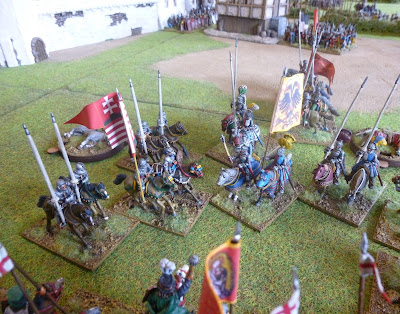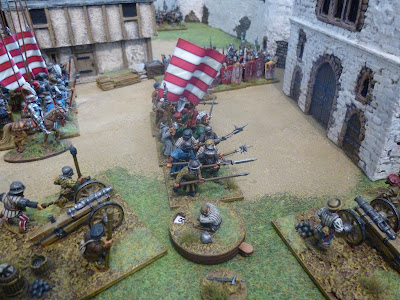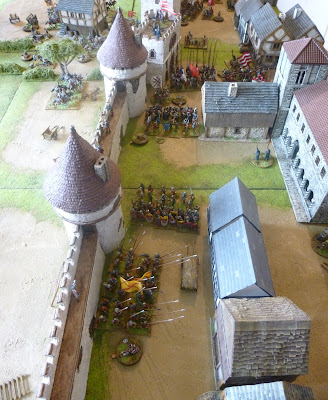This weekend my friend Tom visited for a wargame and despite the "orchard disaster" I encountered in our game in February, http://camisado1500s.blogspot.com/2023/02/the-siege-of-modon-1500.html, we decided to try another storming a city based scenario. It was a chance to try out some different rules for siege style games and as Tom volunteered to play the attacking army it meant I could have a go playing as the defender.
 |
| Always one to put a positive spin on things Maximilian I included the sacking of Stuhlweißenburg as an event to be commemorated on his Triumphal Arch of 1515. The dress of the landsknecht reflects the 1510s and not how they would have looked in 1490. |
The storming of Stuhlweißenburg
The Hungarian King, Matthias Corvinus, famously the leader of the Hungarian "Black Army", died in Vienna on 6 April 1490. He had taken the city on 1 June 1485, entering in triumph at the head of 8,000 of his veteran troops after campaigning successfully against the Holy Roman Emperor, Frederick III. Corvinus's death less than 5 years after his victory led to fighting in Hungary between the forces of his illegitimate son, John Corvinus, and King Vladislaus of Bohemia, both men seeking the throne. Frederick III's son , Maximilian I, proclaimed "King of the Romans" by his father in 1486, saw an opportunity caused by the instability in Hungary. In July of 1490 he began a campaign to reclaim the lands his father had lost to the Hungarians. Maximilian recaptured fortresses and towns through a series of sieges and entered Vienna in August.
With his own ambitions to become king of Hungary Maximilian managed to raise the finances to recruit a mercenary army of cavalry and landsknecht, the latter still being very new arrivals on the battlefields of Europe in 1490. He would lead these men into Hungary. His forces also included the more established Swiss reisläufer. At this date the hatred between the two forces had yet to develop. A later chronicler from St. Gallen would recount "in this campaign , there were many confederates (ie the Swiss) and also some from our town of St. Gallen with the landsknechts".
At the head of 18,000-20,000 men Maximilian advanced into Hungary, his men taking Szombathely on 17 October. There were already grumblings over pay within the ranks of the mercenary army as well as complaints over the cold weather. In response to this Maximilian and some of the accompanying German nobility vouched to cover any arrears in pay. Satisfied for now the army marched on with Veszprém falling on 8 November where the German forces waited for 5 or 6 days, possibly due to more discipline issues within the ranks. The Hungarian diet had elected King Vladislaus of Bohemia as king and his generals Stefan Báthori and Kinizsi Pál retreated towards Buda leaving only 500 men to defend the ancient capital of Hungary, Székesfehérvár or Stuhlweißenburg in German. Reports reached Maximilian that it was poorly defended and the prospect of looting the prestigious city encouraged his men to march on.
Székesfehérvár, known colloquially as Fehérvár or the "White Castle", was a walled city surrounded by swampland. Some of the suburbs had been burnt in an attempt to prevent the attacking army using them as cover for a siege. On 17 November 1490 Maximilian's army advanced and fighting began in the suburbs. The attack gained momentum with more of the Habsburg forces being committed to the assault. Artillery was fired at the city gates and the walls were scaled by the mercenary troops. Székesfehérvár fell to a chaotic assault with the Habsburg soldiers slaughtering the citizens and looting the city. The ancient capital was sacked and Matthias Corvinus's tomb was not spared in the chaos.
Maximilian entered the city the following day. With his ill disciplined troops continuing to complain about pay and the cold weather Maximilian could not persuade them to march on Buda and he left Székesfehérvár in December. Its German garrison held onto the important Hungarian city until July 1491 when it surrendered to King Vladislaus. The war was concluded by a peace treaty at Pressburg in 1491. King Vladislaus surrendered his claim to Lower Austria and agreed that Maximilian would succeed to the Hungarian crown if Vladislaus left no male heir. Whilst Vladislaus did have a male heir his son, the ill fated Louis II, would fall at Mohács in 1526. This meant the Habsburgs eventually got their hands on the Hungarian throne in line with a treaty made in 1515 at the Congress of Vienna, though this was not without further conflict (see http://camisado1500s.blogspot.com/2021/08/tarcal-1527.html).
 |
| The table at the start of the game. Maximilian's forces have arrived outside the gates of Stuhlweißenburg. |
 |
| A view from above the table showing the key locations of the scenario. The two churches are the objectives of Maximilian's army whilst the "King of the Romans" himself is in the bottom left of the image. The main gate and sally port, which the Hungarian forces can move through, are shown along the walls. |
Scenario
In this game we attempted to refight the storming of Stuhlweißenburg. The city walls were set up across the table with some of the city being represented within the walls.
Objectives
Within the walls of the city were two churches (see the photo above). Maximilian's forces would win the game if they could "loot" the two churches. In order to "loot" a church an infantry unit in Maximilian's army had to move into base to base contact with the church. On the following turn a successful move activation would mean they had looted the church.
The Hungarian defenders would win if they could kill or rout Maximilian himself.
If both players achieved these objectives in the same turn then the game would be a draw.
The City Walls
The Hungarians could move through the walls via the main gates or the sally port (see the photo above). Each took a half move for a unit to move through using a move activation. If any enemy unit was within 2" of the gates or sally port then a Hungarian unit could attack through the gate/sally port.
Maximilian's forces could attempt to blow the main gates down. In order to do this they had to fire a culverin at the gates from no further than 12" away. If they succeeded then the main gates were considered destroyed and the Maximilian player could move cavalry and infantry through them in the same way as the Hungarians.
Hungarian units attempting to "block" the gates could be attacked. This was done by the German unit moving into contact with the gateway and pushing back the Hungarian unit if it lost the combat. This would mean the attacking German unit could then move through the gate as a follow up.
Maximilian's infantry units could also scale the walls. They couldn't cross at the towers, only the walls. They could do this by moving into contact with them. On the following turn a successful attack activation would mean the unit could cross to other side but they had to roll a D6. On a 1-2 the unit took D6 casualties in crossing. On a 3-4 D3 casualties in crossing and on a 5-6 no casualties. A morale test was not be required if casualties were taken in scaling the walls. The thoughts of plunder once in the city had temporarily made the scaling unit fearless!
Deployment
Maximilian's forces deployed within 6" of the suburbs table edge whilst the Hungarians could deploy up to the walls and also outside them (with their bases in contact with the walls or towers).
Maximilian had to start on the table whilst the Hungarians had to deploy at least two Cavalry units outside the walls.
Both sides could choose up to 6 units to start off the table. These could then join the game via a move activation from their side of the table edge.
 |
| The main gate of the city is defended by units of pavisiers and handgunners. |
 |
| Maximilian I is surrounded bv a bodyguard of men at arms and mounted crossbowmen. They are opposed by a force of Hungarian cavalry deployed outside the walls. |
 |
| Much of the city's garrison is still within the walls. |
The Armies
We played the game using our adapted version of Lion Rampant, "Renaissance Rampant" with Tom taking control of Maximilian and his mercenary army whilst I commanded the Hungarian garrison of Stuhlweißenburg or Székesfehérvár. Each army was comprised of two retinues that acted independently. Using the deployment rules above Tom chose to keep two lancer units, one culverin and a unit of landsknecht pike off the table at the start whilst I held two hussar units and a unit of crossbowmen in reserve.
Maximilian I and his mercenaries
Maximilian with his cavalry and guns
1 Unit of Gendarmes (Maximilian I "King of the Romans" - Retinue Leader)
2 Units of Men at Arms
2 Units of Mounted Crossbowmen
2 Units of Lancers
2 Culverins
The landsknecht and reisläufer infantry
1 Unit of Foot Knights (Retinue Leader)
1 Unit of Swiss Halberdiers
2 Units of Landsknecht Pike
2 Units of Swiss Pike
2 Units of Landsknecht/ Swiss Shot
The Hungarian Defenders of Stuhlweißenburg
The Cavalry and guns
1 Unit of Men at Arms (Retinue Leader)
2 Units of Hussars
2 Units of Hungarian Horse Archers
1 Unit of Balkan Horse
2 Culverins
The Garrison Infantry
1 Unit of Foot Knights (Garrison Captain - Retinue Leader)
4 Units of Pavise Infantry with arquebusiers
1 Unit of Halberdiers
2 Units of Crossbowmen
1 Unit of Pike
As always a brief write up follows but the captions under the photos are also a good way to follow the action.
 |
| As the trumpets and drums sound Maximilian's forces advance on Stuhlweißenburg. |
 |
| Landsknecht and reisläufer race for the walls of Székesfehérvár, the "White Castle". |
 |
| The fighting begins as German men at arms drive off Hungarian skirmishers. |
 |
| A view of the assault along the walls. The Hungarian light cavalry are attempting to disrupt the attack. |
 |
| Maximilian I and his personal guard hold back but his mounted forces are being drawn into an escalating fight with the Hungarian cavalry. |
 |
| The Captain of the Hungarian cavalry is successful in defeating some of the German men at arms. |
 |
| Hungarian reinforcements arrive in the form of fearsome hussar units. |
 |
| At the other end of the field Maximilian's mercenary infantry are nearly at the walls. |
 |
| The Hungarian garrison prepare for the assault. |
 |
| There is momentary panic amongst Maximilian's army as a group of hussars attempt to bring down the Habsburg prince. |
As Maximilian's army advanced into the smouldering suburbs of Stuhlweißenburg with drums beating and banners flying it was clear that the city's garrison were not going to give in without a fight. The main gates were defended by a force of infantry whilst Hungarian cavalry were awaiting the attackers outside the walls. Seeing the "King of the Romans" at the head of his army the Hungarian horse moved towards him engaging with the German men at arms and mounted crossbowmen that formed part of Maximilian's retinue.
This was a really interesting game that played out in three distinct phases. In the first phase the Hungarian horse attempted to kill Maximilian outside the walls. This was an exciting start to the game and at moments, especially during the duel with the Hungarian cavalry captain, it looked as if Maximilian would be killed and I would win a quick victory! The attack failed and the Hungarian cavalry were a spent force for the rest of the game. The second two phases were the two waves of attack over and through the walls by Maximilian's infantry. Again these were exciting moments where the success of the mercenary infantry hinged on some key dice rolls. If the landsknecht captain and his foot knight unit had got into the city unharmed they would have caused chaos but instead the unit took five casualties crossing the walls which really weakened the overall attack.
The game ended in a draw with neither of us being able to achieve our objectives but we enjoyed the mechanics for the gate and storming the walls and will try them again. Perhaps an assault using similar rules but giving the attacking force a larger army is the way to go. Alternatively we may play a game where we each control half of the attacking force and race against each other, fighting a pre programmed force of defenders, to reach certain objectives. As is often the case this scenario has given us ideas for more siege games which we will try in the future.










































.JPG)
































